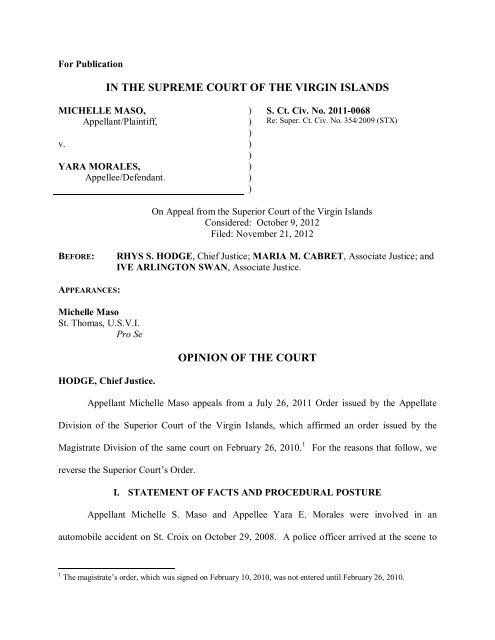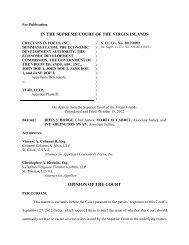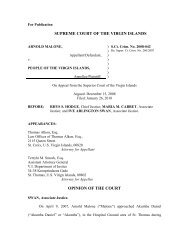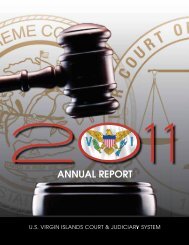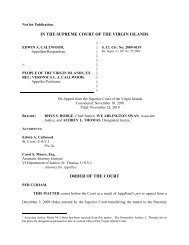IN THE SUPREME COURT OF THE VIRGIN ISLANDS OPINION OF ...
IN THE SUPREME COURT OF THE VIRGIN ISLANDS OPINION OF ...
IN THE SUPREME COURT OF THE VIRGIN ISLANDS OPINION OF ...
Create successful ePaper yourself
Turn your PDF publications into a flip-book with our unique Google optimized e-Paper software.
For Publication<strong>IN</strong> <strong>THE</strong> <strong>SUPREME</strong> <strong>COURT</strong> <strong>OF</strong> <strong>THE</strong> VIRG<strong>IN</strong> <strong>ISLANDS</strong>MICHELLE MASO,Appellant/Plaintiff,v.YARA MORALES,Appellee/Defendant. ))))))))S. Ct. Civ. No. 2011-0068Re: Super. Ct. Civ. No. 354/2009 (STX)On Appeal from the Superior Court of the Virgin IslandsConsidered: October 9, 2012Filed: November 21, 2012BEFORE:RHYS S. HODGE, Chief Justice; MARIA M. CABRET, Associate Justice; andIVE ARL<strong>IN</strong>GTON SWAN, Associate Justice.APPEARANCES:Michelle MasoSt. Thomas, U.S.V.I.Pro SeOP<strong>IN</strong>ION <strong>OF</strong> <strong>THE</strong> <strong>COURT</strong>HODGE, Chief Justice.Appellant Michelle Maso appeals from a July 26, 2011 Order issued by the AppellateDivision of the Superior Court of the Virgin Islands, which affirmed an order issued by theMagistrate Division of the same court on February 26, 2010. 1For the reasons that follow, wereverse the Superior Court’s Order.I. STATEMENT <strong>OF</strong> FACTS AND PROCEDURAL POSTUREAppellant Michelle S. Maso and Appellee Yara E. Morales were involved in anautomobile accident on St. Croix on October 29, 2008. A police officer arrived at the scene to1 The magistrate’s order, which was signed on February 10, 2010, was not entered until February 26, 2010.
Maso v. MoralesS. Ct. Civ. No. 2011-0068Opinion of the CourtPage 2 of 9investigate the accident, recorded the parties’ insurance information and statements, and issued apolice report. (App. 3-9.) The report indicated that, according to Maso, she was stopped at anintersection and Morales hit her when Morales took her eyes off the road. (App. 9.) The policeofficer cited Morales for negligent driving and for causing the accident. (App. 9.)Three weeks later, Maso was driving her vehicle when it began to overheat. After shestopped the vehicle, it alit in flames and was subsequently totally destroyed by the fire. (App.34.) Although Maso claims that she is not sure whether her accident with Morales contributed tothe fire, she did not pursue any claims against Morales relating to that fire or the subsequentdestruction of her vehicle.In the weeks and months after the accident, Morales apparently failed to file a report orclaim with her insurance company. (App. 43-44.) When her insurance company was finallynotified of the accident and of Maso’s claim for damages, it denied Maso’s claim becauseMorales had breached her contract with the company by failing to promptly report the accident.(App. 14, 33.) The company instructed Maso that her only alternative was to file a small claimsaction. (App. 33.)Maso filed a small claims complaint against Morales in the Superior Court on June 9,2009. (App. 1.) She requested judgment in the amount of $3,249.71, which she described as thecost to repair the harm caused by the accident itself, as well as court costs. With the complaint,Maso filed two estimates she obtained in June 2009 regarding the cost to repair the damage toher car. 2Because the car had been destroyed three weeks after the accident, the estimates sheprovided were not based on direct observations of the vehicle or of photographs of the vehicle,2 One estimate concluded that repairs to Maso’s vehicle would have cost her $3,249.71 in parts and labor, and thesecond estimate valued the cost at $3,111.69. (App. 10-13.)
Maso v. MoralesS. Ct. Civ. No. 2011-0068Opinion of the CourtPage 3 of 9but instead were based on Maso’s description of the vehicle and of damage to the car from theaccident as described in the police officer’s accident report. (App. 35.) According to Maso, shegave the body shops that were providing the estimates the car’s make and model and the policereport in order to generate the estimates. (App. 36.)On September 1, 2009, the magistrate held a hearing on Maso’s complaint. Maso andMorales both appeared and testified. Maso averred that Morales was at fault in causing theaccident as Morales admitted to her that she had taken her eyes off the road and did not seeMaso’s stopped vehicle. (App. 32.) Maso also indicated that when she purchased her car, it wasselling for $4,500.00, although because she was friends with the owners, she only paid $3,000.00for it. (App. 38.) Morales did not challenge the reasonableness of the repair amounts stated inthe estimates that Maso had submitted in support of her complaint. 3After hearing from bothparties, the magistrate indicated that the matter would be taken under advisement.Approximately five months later, on February 26, 2010, the magistrate issued an order findingthat while Morales had admitted fault—either to the officer directly, or, at the very least, whenshe paid her traffic ticket—“it is impossible to determine an amount of money that would makethe Plaintiff whole.” (App. 18.) The magistrate noted that there was no evidence that thesubsequent incineration was Morales’s fault, and “to award the Plaintiff the cost of repairs for avehicle that no longer exists would be a matter of unjust enrichment to the Plaintiff.” (App. 18.)On March 11, 2010, Maso petitioned the Superior Court’s Appellate Division for reviewof the magistrate’s decision. No action was taken on the case for six months until September 14,2010, when the Appellate Division judge issued a briefing schedule. Maso filed a brief on3 At the hearing, Morales cross-examined Maso (App. 33-37), but did not pose any questions to her directlychallenging the reasonableness of the amounts stated in the repair estimates. Morales also did not offer anytestimony challenging the reasonableness of those amounts on direct or cross-examination. (App. 39-48.)
Maso v. MoralesS. Ct. Civ. No. 2011-0068Opinion of the CourtPage 4 of 9October 28, 2010, but Morales did not participate in the review proceedings. No action wastaken on the case for an additional eight months. Finally, on July 26, 2011, the AppellateDivision judge issued an Order affirming the magistrate’s decision. The July 26, 2011 Orderacknowledged that the magistrate had found that there was no evidence the incineration wasMorales’s fault, and agreed with the magistrate that to award Maso the cost of repairs wouldconstitute “unjust enrichment.” (App. 52-53.) Maso filed a Notice of Appeal on August 31,2011, initiating this appeal. 4 Morales has not filed a brief or otherwise participated in the appeal.II. DISCUSSIONA. Jurisdiction and Standard of Review“The Supreme Court [has] jurisdiction over all appeals arising from final judgments,final decrees or final orders of the Superior Court, or as otherwise provided by law.” V.I. CODEANN. tit. 4 § 32(a) (1997). Because the Superior Court’s July 26, 2011 Order was a final order,this Court has jurisdiction. See, e.g., Matthew v. Herman, 56 V.I. 674, 677 (V.I. 2012) (statingthat a final order is one which disposes of all claims submitted for adjudication).Whenreviewing decisions of a judge of the Appellate Division of the Superior Court, we typicallyconsider the underlying rulings made by the magistrate only to the extent that they were adoptedor affirmed by the judge of the Appellate Division. Browne v. Gore, S. Ct. Civ. No. 2011-0012,2012 WL 4195994, at *4 n.5 (V.I. Sept. 19, 2012); cf. Welch v. Heckler, 808 F.2d 264, 266-6744 Maso’s Notice of Appeal was untimely. V.I.S.CT. R. 5 (requiring civil appeals to be filed within thirty days ofthe date of entry of the judgment or order from which the appeal is taken). On September 23, 2011, this Courtrequested that the trial court make an “excusable neglect determination.” On December 29, 2011, having not yetreceived a response from the trial court, this Court directed the Superior Court clerk to transmit updated docket entrysheets. Finally, on January 23, 2012, the trial court issued an order requiring Maso to justify her delayed response.Maso did so on January 27, 2012. Months later, on April 3, 2012, the trial court signed an order—which was notissued until April 10, 2012—concluding that Maso had presented sufficient evidence to support an “excusableneglect” finding. That order was filed with this Court on April 13, 2012. Thereafter, on April 13, 2012, this Courtaccepted the notice of appeal based on the Superior Court’s finding notwithstanding its untimely filing.
Maso v. MoralesS. Ct. Civ. No. 2011-0068Opinion of the CourtPage 5 of 9(3d Cir. 1986) (noting that when the Department of Health and Human Services’ AppealsCouncil affirms an Administrative Law Judge, the Third Circuit directly reviews the ALJ’sfindings, but where the Appeals Council’s ruling conflicts with that of the ALJ, only the AppealsCouncil’s ruling would be reviewed as a final decision). In most cases, we will decline todirectly review the magistrate’s rulings, out of consideration for the “unique relationship”between the Magistrate and Appellate Divisions of the Superior Court, and traditional appellatepractices. Browne, 2012 WL 4195994, at *4 n.5. 5B. Whether Maso is Entitled to DamagesThe Superior Court denied any relief to Maso, aside from court costs, because it statedthat awarding her the cost of repairing a car that no longer exists would constitute “unjustenrichment.” 6,7Because the Superior Court appeared to conclude that a damages award isalways unavailable under these circumstances, the Order will be reversed. Neither the AppellateDivision judge, nor the magistrate whose decision the judge was affirming, cited any authorityfor the proposition that a claimant must still possess the personal property for which she isasserting a claim of damages in order to recover property damages. Considering the purposesand principles underlying damages awards, we find this proposition to be contrary to the law,and we hold that plaintiffs may obtain damages even if they no longer possess the subject5 However, when we apply the same standard as the judge of the Appellate Division, we may exercise our discretionand, in the interests of judicial economy, look past the Appellate Division judge’s decision and directly review themagistrate’s rulings. Browne, 2012 WL 4195994, at *4 n.5.6 It is notable that, although the court concluded that Maso was not entitled to any damages, it did award her courtcosts, which are generally only available to prevailing parties. 5 V.I.C. § 541. See Terrell v. Coral World, 55 V.I.580, 583-84 (V.I. 2011) (noting that section 541 governs costs to the “prevailing party”).7 The magistrate and judge each also indicated that Morales was not at fault for the subsequent destruction of Maso’svehicle. (App. 18, 52.) However, Maso never made a claim against Morales based on the fire or the damage itcaused. Therefore, to the extent that this finding played any role in the orders below—and it is not clear to whatextent, if any, it did play such a role—the rulings also require reversal.
Maso v. MoralesS. Ct. Civ. No. 2011-0068Opinion of the CourtPage 6 of 9property as the result of some supervening act that destroys the property.Damages are awarded:(a) To give compensation, indemnity or restitution for harms;(b) To determine rights;(c) To punish wrongdoers and deter wrongful conduct; and(d) To vindicate parties and deter retaliation or violent and unlawful self-help.RESTATEMENT (SECOND) <strong>OF</strong> TORTS § 901 (1979). 8These purposes form the basis for the rulesfor determining the measure of damages in tort. Id. Even where a claimant no longer possessesthe property, a damages award serves to accomplish many of these goals. For instance, thedamages award could deter the defendant from future wrongful conduct, and may vindicate theplaintiff’s rights such that she avoids engaging in self-help. See Schwartz v. Hasty, 175 S.W.3d621, 626 (Ky. Ct. App. 2005) (“[U]nless the tortfeasor is required to pay the full extent of thedamages caused, the deterrent purposes of tort liability will be undermined”).Therefore,permitting a recovery of damages even where the property no longer exists satisfies the purposesof such awards. Id.Furthermore, the value of such an award is not impossible to ascertain.As theRestatement provides,When one is entitled to a judgment for harm to chattels not amounting to a totaldestruction in value, the damages include compensation for(a) The difference between the value of the chattel before the harm and the valueafter the harm, or, at his election in an appropriate case, the reasonable cost ofrepair or restoration, with due allowance for any difference between theoriginal value and the value after repairs, and(b) The loss of use.8 In the absence of a local law on the subject, or binding case law, Section 4 of Title 1 provides that the Restatementsof Law shall be the rules of decision applied by the courts. 1 V.I.C. § 4. See also Banks v. Int’l Rental & LeasingCorp., 55 V.I. 967, 980 (V.I. 2011) (indicating that this Court may create common law rules, and, therefore, thisCourt is not bound by the Restatements).
Maso v. MoralesS. Ct. Civ. No. 2011-0068Opinion of the CourtPage 7 of 9RESTATEMENT (SECOND) <strong>OF</strong> TORTS § 928. Consequently, a plaintiff could provide evidence ofthe value of her property before it was harmed, and after, and the difference would constitute herdamages award. Alternatively, at her election, she could provide evidence of the cost to repairthe property. See Int’l Rental & Leasing Corp. v. McClean, 303 F. Supp. 2d 573, 577 (D.V.I.App. Div. 2004) (“While the trial court may reduce damages or choose to not award damages ifthe plaintiff’s estimate is unsupported or inaccurate, the trial court may not completely rejectcompensatory damages simply because the plaintiff chose one reasonable means of estimatingdamages instead of another.”). This evidence does not require that at the time of the litigation,the plaintiff still possess the property; the evidence could be acquired before the plaintiff loses,sells, destroys, or otherwise becomes dispossessed of it. The subsequent destruction of propertywill not bar recovery in every case. 9 See Rafal v. Rafal, 198 A.2d 177, 178-79 (Del. Ch. 1964)(in a divorce proceeding in which the wife was alleged to have impermissibly taken her spouse’sproperty, stating that the subsequent destruction of the property by fire prevented the court “fromhaving specific evidence as to the condition of the property at the time it was taken,” but did notdeprive the claimant of damages, because “[t]he court must do the best it can”).Deciding that a plaintiff could succeed on a damages claim even where the property wassubsequently destroyed by an independent act does not entirely resolve Maso’s case. Maso must9 Indeed, there is no extant authority for the proposition that a claimant’s property must not be subsequently destroyed inorder for her to succeed on a claim for damages, or to establish the value of that damage. The judges’ contrary interpretationof the law of unjust enrichment in this case must be expressly rejected. Typically invoked in breach of contract or quasicontractsuits, unjust enrichment is defined as the “retention of a benefit conferred by another, without offeringcompensation in circumstances where compensation is reasonably expected.” Peppertree Terrace v. Williams, 52 V.I. 225,242 (V.I. 2009) (Swan, J., concurring) (citing Black's Law Dictionary 1573 (8th ed. 2004)). “One is not unjustly enriched byreceipt of that to which he is legally entitled.” Smith v. Whitener, 856 S.W.2d 328, 329 (Ark. Ct. App. 1993) (citingMerchants & Planters Bank & Trust Co. v. Massey, 790 S.W.2d 889 (Ark. 1990)). “To find unjust enrichment, a party musthave received something of value to which he is not entitled and which he should restore.” Id. Awarding Maso damages forthe cost of repairing her car where the car was subsequently destroyed does not meet this definition. The magistrate foundthat Morales’s negligence caused the accident, creating a legal right to recovery. There can be no unjust enrichment wherethe person enriched is legally entitled to the enrichment.
Maso v. MoralesS. Ct. Civ. No. 2011-0068Opinion of the CourtPage 8 of 9have established the value of the loss she suffered. However, she need not establish this value toan exactitude.See RESTATEMENT (SECOND) <strong>OF</strong> TORTS § 912 (“One to whom another hastortuously caused harm is entitled to compensatory damages for the harm if, but only if, heestablishes by proof the extent of the harm and the amount of money representing adequatecompensation with as much certainty as the nature of the tort and circumstances permit.”(emphasis added)); see also Holmes v. Freeman, 185 A.2d 88, 91 (Conn. Super. Ct. 1962)(“Where from the nature of the case the amount of damages cannot be proven with exactitude, allthat can be required is that the evidence, with such certainty as the nature of the case may permit,lay a foundation which will enable the trier to make a fair and reasonable estimate.”); seegenerally Dado v. Jeeninga, 743 N.E.2d 291, 296 (Ind. Ct. App. 2001) (interpreting theRestatement, among other authorities, and noting the general rule that once a plaintiff providesevidence of repair costs, the defendant bears the burden of establishing that such an award would“yield a windfall”).Here, Maso attempted to establish her damages by providing estimates from body shops,estimates which were based not on any direct observation of the vehicle, but on the damagesdescribed by the police officer in his report and on her descriptions of the vehicle. There is nodispute that the accident occurred and caused damage to Maso’s vehicle; the police officerobserved and recorded the damage and Morales admitted to observing some damage to Maso’svehicle. (App. 46.) In addition, Morales was presented with ample opportunity to challenge thereasonableness of Maso’s damages estimate based on the repair estimates that she had obtainedand submitted to the magistrate in support of her complaint, but Morales failed to avail herself ofthat opportunity at the September 1, 2009 hearing. As earlier noted, Maso was not required toestablish her damages to an “exactitude”; instead, she was required to prove her damages with
Maso v. MoralesS. Ct. Civ. No. 2011-0068Opinion of the CourtPage 9 of 9“as much certainty as the nature of the tort and circumstances permit.”RESTATEMENT(SECOND) <strong>OF</strong> TORTS § 912. While the determination of the correct value of the damages may bea difficult judicial task, it is nonetheless one that the court must undertake. 10 See SUPER. CT. R.64 (requiring small claims cases to be tried in a manner to “do substantial justice between theparties”). What is clear, however, is that a claimant is not deprived of the right to propertydamages simply because the property is subsequently destroyed.CONCLUSIONBecause the Superior Court erroneously concluded that Maso was barred from recoveringany damages due to the subsequent, independent destruction of her vehicle, we will reverse theSuperior Court’s July 26, 2011 Order and remand the case for proceedings consistent with thisOpinion. 11Dated this 21st day of November, 2012.ATTEST:BY <strong>THE</strong> <strong>COURT</strong>:___/s/ Rhys S. Hodge__________________RHYS S. HODGEChief JusticeVERONICA J. HANDY, ESQ.Clerk of the Court10 Of course, in estimating a claimant’s damages the court must be guided by the substantive law of torts. Forexample, a claimant generally may not receive in damages the cost of repair if such cost exceeds the value of theproperty before the accident. RESTATEMENT (SECOND) <strong>OF</strong> TORTS § 928.11 We urge the Superior Court to address this matter in a timely fashion, as significant delays have already impededthe resolution of this small claims case for more than three years.


